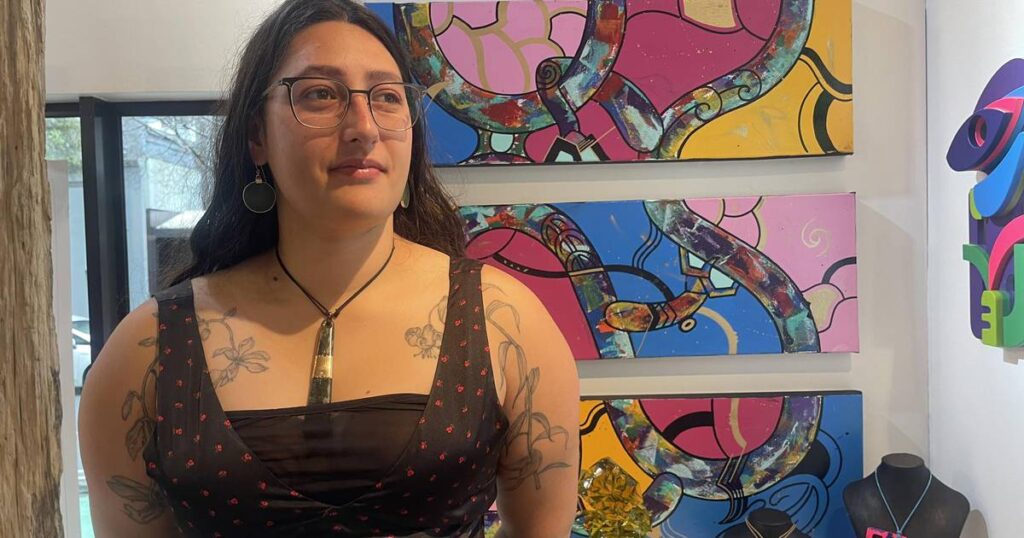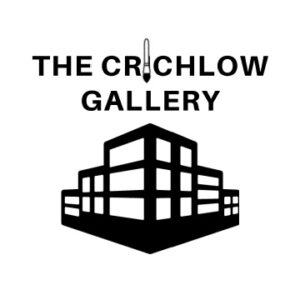Esther Stone of Ngāti Porou is one of a handful of artists whose work is on display at , a collection of art that showcases the many forms of Tiki, one of the most recognised Māori designs
Tiki has so much meaning for our toi Māori practitioners,” exhibition curator Sera Clifton says.
“So I saw it as an opportunity to promote our artist and the spiritual practices that are involved in toi Māori than just using Tiki as a visual image in kiwiana.”
Stone’s piece is called Whakamoe ā Tiki and portrays Tiki in his mother’s womb. The 21-year-old said the Tiki is something she has always known about, having been brought up in the art world and on her marae.
“Because I’m from Ngāti Porou, there’s the waka Nuku-tai-memeha, which was the waka Maui was in when he pulled up the North Island.”
Clifton acknowledges there are different origin stories for Tiki and that they vary from artist to artist depending on iwi and hapū interpretation.
“I know two kōrero of who created Tiki. One is that Tāne created TIki and there’s another kōrero that Tūmatauenga created Tiki and of course, the style of carving of Tiki varies from iwi to iwi as well.”
The Tiki has been appropriated by many companies for monetary gain, being sold on foreign websites without any acknowledgement of Māori or sharing of profits.
“Seeing it appropriated for monetary gain and hearing the stories of pounamu being sent overseas to be carved and then brought back is really sad,” Stone says.
The exhibition, at Kura Gallery in central Auckland opened today and will run to next Saturday, October 14.
Exhibiting artists:
Alex Sands (pounamu carver) Ngāti Kahungunu Ki Wairoa
Sands was born in Hamilton in 1994. He spent the early part of his life in China, and at the age of 13 was given the opportunity to learn from one of the master jade carvers and has since gained his diploma in Māori wood carving.” My work has always been about me stretching my limits, doing things that are said to be difficult or impossible, always continuing to reach and learn more.”
Helen Keen (painter)
Keen uses the ancient process of encaustic wax to make her beautiful works, a process first used in ancient Egypt by boat builders and then adopted by artists, Her works are both visually stunning and tactile.
Justin Kite (printmaker, painter) Ngāti Kahungunu
Justin is both a printmaker and a painter. Visually, his influences involve both Māori and Chinese culture; his stimulus the range of places he has lived and taught art.
“Living and working in a range of different countries has been a major stimulus in my art-making process. I enjoy playing with the relationships and visual hierarchy of silhouettes and internal narratives to achieve contradictions and surreal worlds. Taking observations of diversity and everyday situations. I play with the multi-layers of societal contexts, attempting to highlight the complexities and randomness of post-modern life.”
Al Brown (carver) Ngāti Ruaka Ranana (Whanganui River)
Brown has been carving pounamu for over 30 years. He draws strongly from his Māori whakapapa to reflect the beauty of this land and the South Pacific in his work. He can trace his bloodline to the migration of 1350 AD. His work is displayed in national and international museums and Collections and has often been gifted to various countries and dignitaries on state and trade missions.
“When there is love for someone or something a relationship develops- a dialogue of some sort at some level becomes a process of discovery. My work reflects my dialogue and love for the land, our heritage, the present and future and becomes arrows and messengers that fly on into the lives and psyches of unknown ones … Uki Tau e (for generations untold).”
Tim Steel (carver) Ngāi Tahu
TSteel was raised in the coastal town of Pukerua Bay and has always had an interest in collecting beach materials and stones on his travels. His inspiration is derived from ancient civilisations, historical artefacts and the natural aesthetics of Aotearoa. He chooses to express his creativity and concepts in the stone medium through wearable and object art.
Haoro Hond (painter) Taranaki Tuturu, Te Ati Awa
Hond is an emerging painter from Taranaki. He says, My art is the weapon I choose to combat negativity and empower my community”. His works are a fresh take on Toi Maori, always bright and multi-faceted. His works hold both a great deal of knowledge and contemporary style.
Connor Jeory Ngāti Porou (carver)
A self-taught artist, Jeory is passionate about the history of his area and puts his hand to a variety of mediums that allow him to tell his stories of observation and experience living on the East Coast. His work has sold to both international and local collectors.
“The clear felling of forests for unimpeded farmland, which is kept clear by fences and pastured cows and sheep, reveals dramatic bones. A landscape completely carved by generations of farmers who have maintained the legacy of pastoral farming – a legacy that has disastrous environmental consequences: the erosion leading to silting up of rivers, inundation of coastal eco-systems and of course the haunting deathly absence of biodiversity through monoculturalism.”
David Brosnahan Ngati Kahungunu, Ngāti Pahauwera
“All of my artwork has its foundations grounded in Māori heritage, I enjoy working with wood, especially New Zealand native timbers. Colour harmony and working with colour is another passion. My work is always influenced by my surrounding environment whether in New Zealand or living overseas. I enjoy using art to connect and learn about other cultures, I see my role as an artist also as a potential bridge builder, cultural broker and teacher, Art can be a window into which different cultures can understand and learn from one another.
This content was originally published here.



